Show And Sell; John Conn And The Fine Art Of The Street Sale
John Conn is telling me about the Arnolds.
"They're the ones who look at the photos and say, `I'll
be back.' Trust me, they won't." Then there are the pointers.
"Pointers never buy," he says, "and buyers never point. If
someone points, I don't get up and walk over." Other sure-fire indications
of a kiss-off: "If they ask for a card. Or if they ask, `Are you
here all day?'"
John At Union Square. See Something You Like? |
|
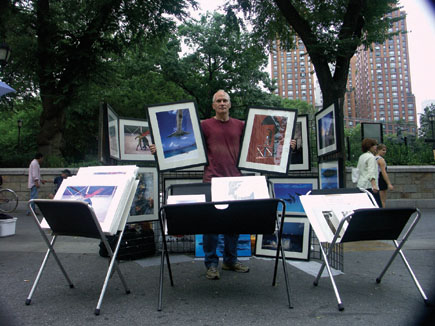 |
|
|
Speed flippers tend to annoy him.
"They flip through the work while talking on their cell phones, and they'll
never push the stacks back--even though I have a sign: If you can flip
it forward, you can flip it back."
What I'm hearing is hard-won street savvy, delivered by a photographer
who's spent three years selling his work in Union Square in New York City
and at various art shows in the New York-New Jersey-Connecticut area. There's
a lot more to come, but I stop him there for a moment. What I want to know now
is what inspired John, a versatile, resourceful freelancer who's handled
everything from restaurant interiors to underwater photography in a career that
spans 30 years, to take his images to the streets.
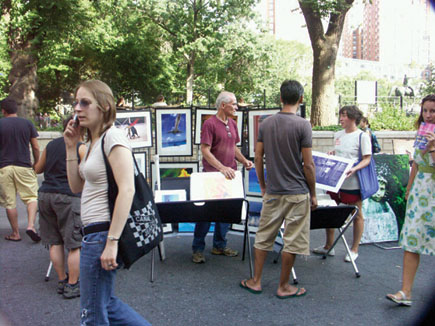 |
"The Metropolitan Museum of Art," he says. "Well, actually,
the sidewalk in front of the Met, where I'd see all these people setting
up and selling photographs. I thought that might be something to do on the weekends."
He began with a simple A-frame easel and a handful of photographs, but quickly
discovered that the location was far from ideal. "Too many tourists,"
he says. "They didn't want to bring framed or matted art home; it
was too inconvenient." So John took the show downtown to Union Square,
where city residents and suburbanites who drive to the city are more likely
to buy.
And often more likely to want to talk shop. "When people ask me about
my photography and I tell them I'm shooting Fujichrome, they look at me
like I'm a god," John says. "I guess it makes me seem more
of an artist. Like I'm still doing things the hard way."
Knife, New York City Subway, Sometime In The
1980s |
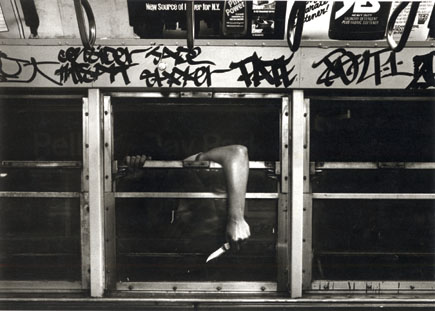 |
John won't disavow their belief. He's there to sell, and if shooting
film increases their respect for him, and their inclination to buy a print,
so be it.
If they ask why he still shoots film, he's likely to answer, "Because
with film I don't have to look at the back of the camera." He's
only half-kidding. "I look through the viewfinder, I know what I have.
I take a shot or series of shots and I walk away. I know I've got it.
I was a photographer in the Marine Corps in '68, I've been doing
this a long time."
While the source is silver halide, the prints people buy from John are digital.
"I explain that I shoot slide film, scan the transparencies, and print
the digital files. Sometimes I have to explain what a transparency is. To a
lot of people, before digital there was nothing."
Arches (Down To The Sea) |
Greek Boat |
 |
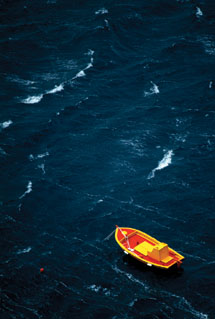 |
He will engage potential customers in conversation, but he makes it clear
he's not there to schmooze photography. "If I'm talking about
photography, I'm not selling. But I'll talk when things are slow.
Sometimes people will try in a roundabout way to find out how you do this--how
you set up and sell this way. The people who want to buy tend to ask for a little
history of the photo and want to know how I took it. But some people just like
to come down and try to bond with you." When that happens, the Union Square
artists have signals that alert neighboring exhibitors that a cell phone rescue
call would be appreciated.
Other than relying on an occasional bit of neighborly help, John is, from the
shooting to the selling, a one-man show. He scans his 35mm and 21/4 transparencies
(on an Epson GT-7000), makes his own prints (on an Epson R1800 for color, a
3800 for black and white), and does his own matting and framing. "The
real reason I stay with film is that I think it gives me richer colors and better
saturation in all my prints. I'll do some Photoshop work on the files,
maybe adding some contrast or doing a minor color adjustment to bring the print
back to the slide. With black and white I'm doing the Photoshop equivalent
of burning and dodging."
These days Union Square is his preferred place. For other shows, he says it
was important to find out who the good promoters were. "I checked online,
in books and in Sunshine Artist, an arts and crafts show magazine that lists
art shows. I try to stay away from shows that promote themselves as `art
and craft'--`craft' is a word to avoid. You wind up at
shows where people are making sweaters and rugs, guys are carving little wooden
birds and selling glass figurines."
Airplane |
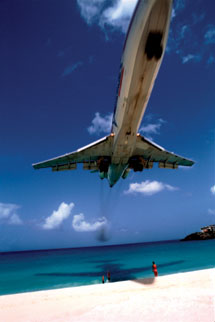 |
The art shows offer the advantage of a reserved space. Sign up, pay your fee,
and you're guaranteed a spot. In Union Square, where no permit is needed,
only a tax ID, it's first come, first served. "The key thing is
your neighbors," John says of the square. "If your neighbors are
jerks, it's going to affect your sales. If someone throws a blanket on
the ground and starts selling crack pipes...well, people tend to avoid that.
If you're next to him, you're going to have a lonely day."
Here's what's important: First, the layout of the photos. "You
put the colorful ones in front," John says. "The animal shots draw
in kids, so if there are going to be a lot of kids, keep the animal shots low.
Keep the airplane shot prominent--it draws in the macho guys. The arches
and the Greek boat, women like those. And watch the patterns of the colors--you
don't put two blue tones together; vary the color because color draws
them in."

















































